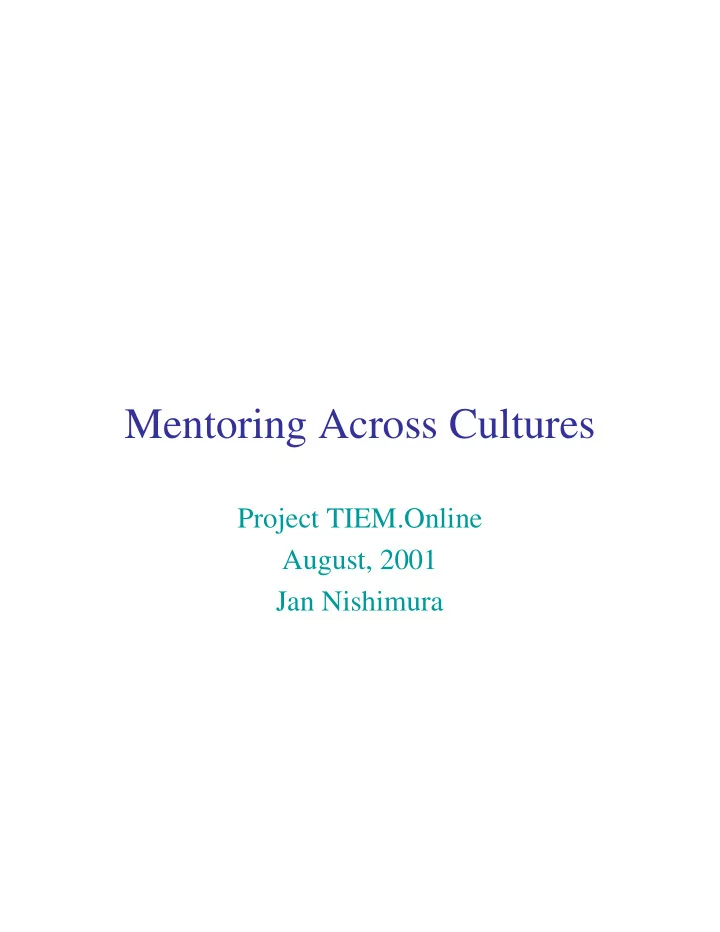

Mentoring Across Cultures Project TIEM.Online August, 2001 Jan Nishimura
With grateful appreciation to all those on whose shoulders we stand and all those who were willing to talk story.
My Favorite Mentor
Mentoring Roles Peer Coach Boss Sponsor Mentor Guide
Mentoring Functions • Career • Psycho-Social Sponsorship Role Modeling Exposure and Acceptance and Visibility Confirmation Coaching Counseling Protection Friendship Challenging Assumptions
Nature of the Relationship • Is the mentor chosen or assigned? • What are the goals and motivation of the mentoring interpreter? • What is the motivation of the mentor? • How much time commitment involved? • Is the mentoring towards a specific model? • What are the environmental/setting variables?
Responsible Mentoring A one-to-one relationship or partnership that focuses on the needs of the mentored participant; helps an individual develop his/her own vision for the future. (Effective Practices, National Mentoring Partnership)
Dimensions of Diversity The Seen Gender Race Physical Abilities Age Demeanor
Dimensions of Diversity The Unseen Experience Gender Race Education Income Upbringing Beliefs Physical Abilities Age Family Work Demeanor
Cultural Continua • Small family • Extended family • Individuality • Interdependence • Independence • Nurturing of children • Time is measured • Time is given • Youth, future • Respect for age • Individual ownership • Broad ownership • Equal rights and • Differentiated rights and responsibilities responsibilities • Control • Harmony
Being a culturally sensitive mentor… Where do I begin?
Simply put, one who is culturally competent… Is aware of cultural diversity and has the skills needed to interact successfully with people of diverse cultural backgrounds
Cultural Competence: Awareness, Understanding, Skills and Application • Ability to generate a wide variety of verbal and non-verbal responses • Ability to send and receive verbal/non- verbal messages • Awareness of self, including impact on “Other
Self Awareness • Aware of one’s heritage, values, beliefs and feelings • Values, respects and is comfortable with differences • Understands how values/biases affect “Others”
Me and My Place in the World For each group of which I am a member: How do Others How do I feel about it? view me? Who are the “Others”? How does Society view me? How do I feel about How does Society “The Others” view “The Others”?
Awareness of “Other” • Identifies the “Other” group(s) • Understands what “Other”ness means • Aware of societal view of “Other”ness
Learning About Other Cultural Perspectives • Learning through books, the arts and technology • Talking with individuals who are members of that culture • Participating in the life of the culture • Learning the language of the culture
Bridges to “Others” • Cultural informants • Cultural advisors • Cultural mentors • Go-betweens
Case Studies A, B & C • Imagine that you are the mentor in these scenarios. Define who you are, the parameters of the mentorship, the setting and the location. • Are there issues that need to be addressed? If so, what are they? • Who is the best person to address them? • What other resources could you have to support the interpreter? • How would your response change given a change in one of the variables?
Case Study A • 23 year old Mexican American male, fluent in Spanish and English and enthusiastically learned ASL; hard worker • Late in the morning; apologizes, no explanation • Caring for elderly grandmother
Case Study B • Interpreter is young female, orthodox Muslim • Wears traditional outfits, including scarves which cover her head, tie under chin and down front of her coat • Good student, actively goes to Deaf community, volunteers at children’s hospital
Case Study C • Interpreter is 22 year old Korean-American who immigrated to the U.S. 15 years ago • Interpreter’s spoken English is accented and occasionally halting in gramar • Her behaviors are quiet, shy and deferential
Case Studies D, E and F • What factors do you see involved in each scenario? • How might the mentoring interpreter have felt? • What might have been the motivations of the mentor? • Could it have been handled differently?
Case Study D • Interpreter is African American female, mid 30’s, her 2 nd career • Mentor is Euro-Caucasian female, 40’s • Mentor attends Ebonics lecture and receives vocabulary lists • At next meeting, Mentor asks interpreter to sign Ebonics vocabulary • Mentor nods in approval when interpreter correctly signs meaning
Case Study E • Interpreter is 24 year old Latina who was raised bilingually (Spanish/English) • Mentor is Euro-Caucasian male, early 30’s. • Diversity Day celebration, Latin band; interpreter signs from Spanish to ASL • Mentor indicates “Switch now!” • Mentor expects interpreter to feed Spanish to ASL because he doesn’t understand Spanish
Case Study F • Interpreter is 22 year old Native American female, aware of her culture, and involved with Native Deaf • Mentor is non-Native American female in her 40’s. • Mentor demonstrates sign for “Indian” • Interpreter, after long pause, tries to demonstrate sign used by Native Deaf • Mentor tells interpreter she’s wrong • Interpreter had not disclosed her background
Towards a New Philosophy of Mentoring, Learning & Appreciation • Be interested • Be understanding • Be non-judgmental • Be open • Be respectful • Be willing to wait • Be willing to laugh at yourself • Expect to be surprised ☺
It is good to have an end to journey towards; But it is the journey that matters in the end Ursula K. LeGuin
Recommend
More recommend